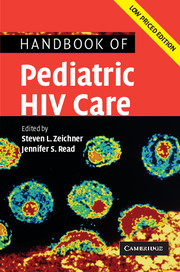Book contents
- Frontmatter
- Contents
- List of contributors
- List of abbreviations
- Foreword
- Preface
- Part I Scientific basis of pediatric HIV care
- Part II General issues in the care of pediatric HIV patients
- Part III Antiretroviral therapy
- 11 Antiretroviral therapy
- 12 Antiretroviral drug interactions
- 13 Metabolic complications of antiretroviral therapy in children
- 14 HIV drug resistance
- 15 Initiating and changing antiretroviral therapy
- 16 Therapeutic drug monitoring
- 17 HIV postexposure prophylaxis for pediatric patients
- Part IV Clinical manifestations of HIV infection in children
- Part V Infectious problems in pediatric HIV disease
- Part VI Medical, social, and legal issues
- Appendix 1 Formulary of antiretroviral agents
- Appendix 2 National Institutes of Health sponsored clinical trials for pediatric HIV disease
- Appendix 3 Selected HIV-related internet resources
- Appendix 4 Selected legal resources for HIV-infected children
- Index
- References
14 - HIV drug resistance
Published online by Cambridge University Press: 23 December 2009
- Frontmatter
- Contents
- List of contributors
- List of abbreviations
- Foreword
- Preface
- Part I Scientific basis of pediatric HIV care
- Part II General issues in the care of pediatric HIV patients
- Part III Antiretroviral therapy
- 11 Antiretroviral therapy
- 12 Antiretroviral drug interactions
- 13 Metabolic complications of antiretroviral therapy in children
- 14 HIV drug resistance
- 15 Initiating and changing antiretroviral therapy
- 16 Therapeutic drug monitoring
- 17 HIV postexposure prophylaxis for pediatric patients
- Part IV Clinical manifestations of HIV infection in children
- Part V Infectious problems in pediatric HIV disease
- Part VI Medical, social, and legal issues
- Appendix 1 Formulary of antiretroviral agents
- Appendix 2 National Institutes of Health sponsored clinical trials for pediatric HIV disease
- Appendix 3 Selected HIV-related internet resources
- Appendix 4 Selected legal resources for HIV-infected children
- Index
- References
Summary
Introduction
One of the most challenging limitations of antiretroviral therapy is the emergence of drug resistant mutants of HIV, which occurs in 30%–40% of treated patients. For the individual, drug resistance renders antiretroviral therapy much less effective, resulting in the return of HIV viremia and disease progression. Resistant variants are transmitted when new HIV infections occur, and the spread of resistant HIV to newly infected individuals is a growing public health concern. The benefits of HIV resistance testing have been reported in several clinical trials; resistance testing is recommended in certain clinical situations in adult populations. Many questions remain however, and methods to study and analyze HIV drug resistance continue to evolve. Several excellent reviews on HIV drug resistance testing have recently been published [1–8].
Collections of drug resistance mutations are often depicted in tables (see Tables 14.1 and 14.2); such tables, although useful, do not depict degrees of resistance or complexities of interactions among mutations. Online compendia of mutations, frequently updated (e.g., hivdb.stanford.edu, hiv-web.lanl.gov (a sequence compendium of utility for researchers), www.hivresistanceweb.com, www.iasusa.org/resistance_mutations/index.html) provide additional information concerning antiretroviral resistance mutations.
Mechanisms of drug resistance
Studies of HIV replication suggest that HIV populations in vivo are characterized by high genetic diversity; as a result it is likely that some HIV drug resistance mutations are present even prior to the initiation of antiviral therapy. Initiation of antiretrovirals serves to suppress sensitive HIV and permit growth of resistant virus.
- Type
- Chapter
- Information
- Handbook of Pediatric HIV Care , pp. 397 - 414Publisher: Cambridge University PressPrint publication year: 2006
References
- 1
- Cited by



